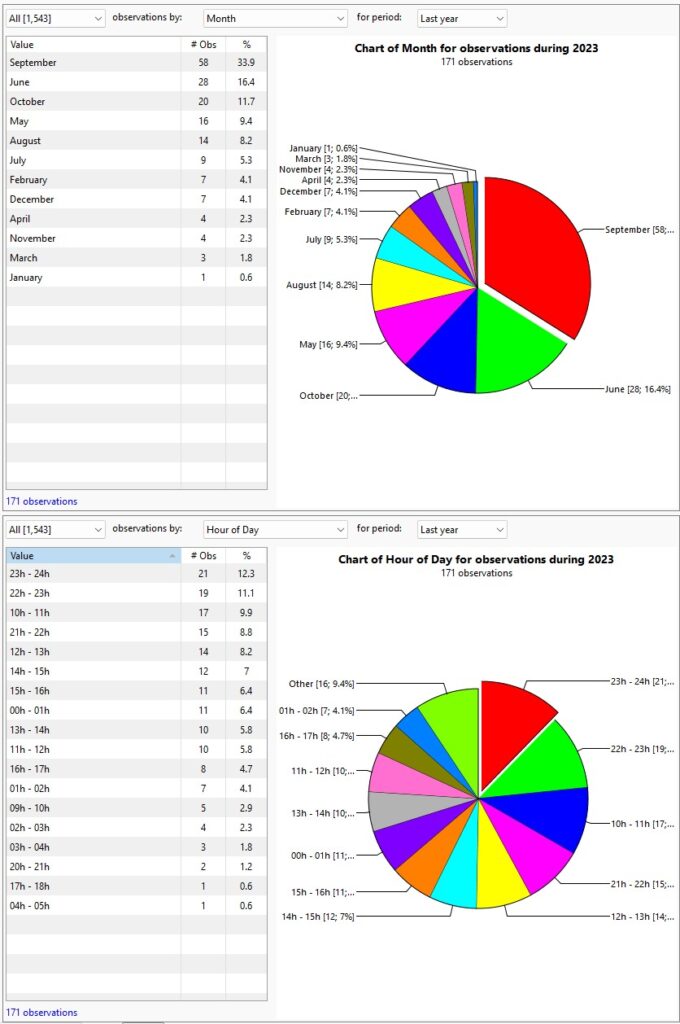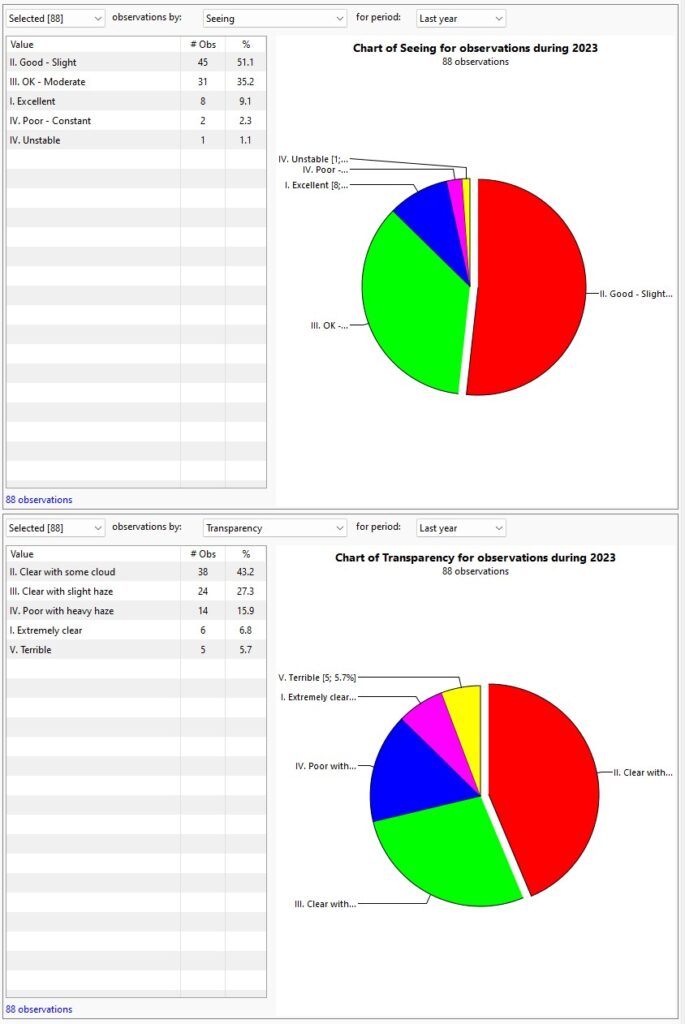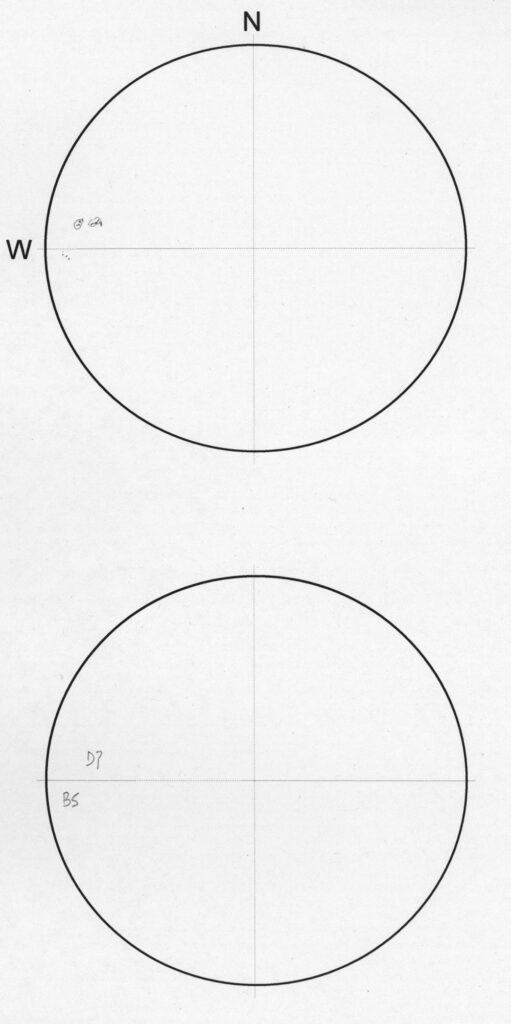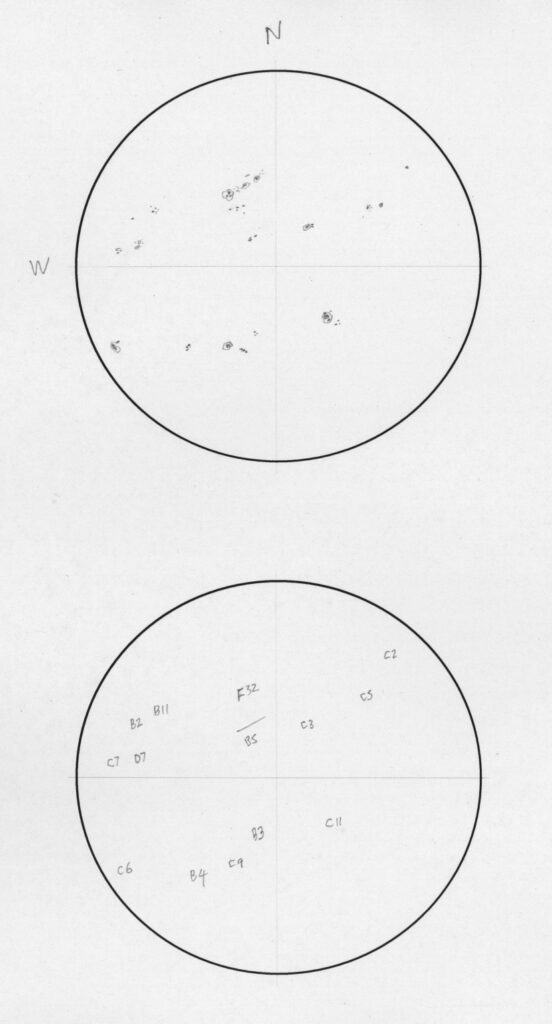The most exciting thing this year has been the discovery of EAA ( Electronic Assisted Astronomy). For me, it feels just like doing astronomy when looking through an eyepiece. I get the same experience that you get after you have been staring at the object for a priod of time. When you start, everything is faint and ill defined. but as the stack grows, more and more is revealed.
I find that you don’t really need more than 5 – 10 mins of stacking to get to a point that adding more doesn’t enhance the experience that much. If I’m following an observing guide, that then gives me more time to read up on the object notes and find out more about what I’m looking at and even discover others observations of detail that I might have missed on first look.
While a camera is being used, I don’t consider this discipline to be ‘astrophotography’ – the images are far too coarse for this. The whole process seems to run at a similar pace to the way I used to observe at the scope, which is 7 to 10 objects on a good night .
The biggest upside for me is you don’t have to stand up or sit in a crouched position at an eyepiece freezing your tail off. I’m sitting in a nice warm room with the world at my fingertips via a web browser and all my astronomy books.
I don’t have to worry about blowing my night vision, when I want to make a cup of tea, or read some observing notes or look at a screen to record my observation. The whole process is a lot more civilised and comfortable.
Observing Stats for 2023
Astroplanner may be a pain in the butt sometimes, but one thing it does really well is produce statistics of your observations.
This year I just sneaked past 1500 individual target observations since I started to record all this stuff, way back in August of 2011.
Observations by Observation Plan & Object Type
Over half of the observations this year were Solar observations, so that confirms there were at least 88 sunny days where the skies stayed clear for long enough to make a drawing and record it. I also passed my 100th solar observation, all of which have been submitted to the BAA and AAVSO solar section databases.
In order to observe things I may not normally come across, I chose to start working my way through Steven James O’Meara’s book ‘Hidden Treasures’ and this accounted for over 22% of observations.
The biggest surprise was to see I’ve observed 15 planetary nebula. This is not a target type I would normally have chosen and all but one were observed by EAA. I see I observed 3 Comets as well and I’d like to do more of these in 2024.

Observations by Hour and Month
OK. This is an anoraky one. September and June had the largest number of observations. This coincided with the heatwave in June and I guess i just had a nice bit of settled weather in September. January was a terrible month with just one solar observation.
The bulk of night time observations took place after 9pm, with the most productive hour being the hour before midnight. The one thing this data doesn’t show is that there is what I call happy hour – which can be anything up to three hours and always occurred after midnight, when the FWHM and HFR numbers dropped like a stone. This always produced the best clarity of observation.

Observing Conditions by Seeing & Transparency
I’m not sure this one would give an accurate reflection of what’s happening across all observation types.. It’s difficult to quantify a seeing or transparency value on a scale that was designed around a MK1 eyeball assessment, when you are doing EAA or imaging at night, so I have only selected daytime Solar observations here to give a feel of what conditions are like.
On the 88 sunny days I was able to observe seeing was mostly II: Good with slight limb movement and transparency that was II: Clear, with some broken cloud.

Sunspot Activity
You can see increasing activity from the start of the year which then peaks during June, but then quietens down towards the end of the year. The last observation of the year was on the 28, November and I’ve not had a clear day in December at all. Lets hope that last observed spike shows an increasing trend of activity going into 2024.
Just to give you a sense between a low and high activity Sun this year, here are a couple of drawings. The Low activity on the left has an R of 32 with the other an R of 247.


So what do I want to do in 2024? Top of the list is to observe NGC253. It’s been the one final target from my Caroline Herschel observing programme for years. Get that logged and Miss Herschel’s list of discoveries is done.
I also came across an S&T article on observing objects greater than 1GYR. I didn the most distant on that list of galaxies, which were considered to be a visual challenge in large scope, as found both of them in a couple of 15 sec exposures. In EAA land I need to go out farther, so would like to see how far I can go in say 10 mins of stacking.
Then there’s Comets. These have always been terribly disappointing visually and I think EAA would be the perfect tool to hunt down some of the fainer ones and maybe see how they change with time.
Finally there are the S J O’Meara observing guides. I’ve started Hidden Treasures and have come across so many targets I wouldn’t normally seek out and have thoroughly enjoyed the experience.
With most of December and part of January 2024 being a complete washout with the terrible weather, let’s hope the Cloud Lady gives us a break soon.